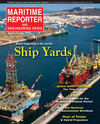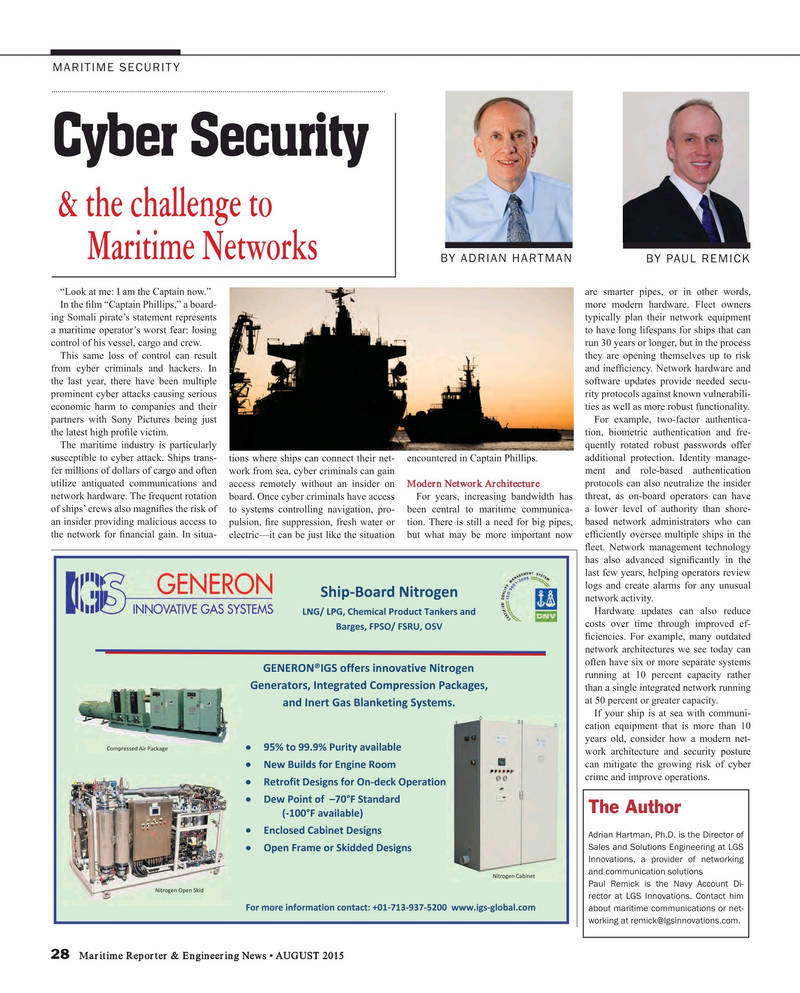
Page 28: of Maritime Reporter Magazine (August 2015)
Shipyard Edition
Read this page in Pdf, Flash or Html5 edition of August 2015 Maritime Reporter Magazine
MARITIME SECURITY
Cyber Security & the challenge to Maritime Networks
BY ADRIAN HARTMAN BY PAUL REMICK “Look at me: I am the Captain now.” are smarter pipes, or in other words,
In the ? lm “Captain Phillips,” a board- more modern hardware. Fleet owners ing Somali pirate’s statement represents typically plan their network equipment a maritime operator’s worst fear: losing to have long lifespans for ships that can control of his vessel, cargo and crew. run 30 years or longer, but in the process
This same loss of control can result they are opening themselves up to risk from cyber criminals and hackers. In and inef? ciency. Network hardware and the last year, there have been multiple software updates provide needed secu- prominent cyber attacks causing serious rity protocols against known vulnerabili- economic harm to companies and their ties as well as more robust functionality.
partners with Sony Pictures being just For example, two-factor authentica- the latest high pro? le victim. tion, biometric authentication and fre-
The maritime industry is particularly quently rotated robust passwords offer susceptible to cyber attack. Ships trans- tions where ships can connect their net- encountered in Captain Phillips. additional protection. Identity manage- fer millions of dollars of cargo and often work from sea, cyber criminals can gain ment and role-based authentication utilize antiquated communications and access remotely without an insider on Modern Network Architecture protocols can also neutralize the insider network hardware. The frequent rotation board. Once cyber criminals have access For years, increasing bandwidth has threat, as on-board operators can have of ships’ crews also magni? es the risk of to systems controlling navigation, pro- been central to maritime communica- a lower level of authority than shore- an insider providing malicious access to pulsion, ? re suppression, fresh water or tion. There is still a need for big pipes, based network administrators who can the network for ? nancial gain. In situa- electric—it can be just like the situation but what may be more important now ef? ciently oversee multiple ships in the ? eet. Network management technology has also advanced signi? cantly in the last few years, helping operators review logs and create alarms for any unusual ^SsÐ?ŽA?EEsl?ŽOGY network activity.
Hardware updates can also reduce >E'?>W'?SGwsÐAuW?ŽE?ÐldAYUG??AYE costs over time through improved ef-
A?OG??&W^K?&^Zh?K^s ? ciencies. For example, many outdated network architectures we see today can often have six or more separate systems 'EZKE?/'^ŽIIG??sYYŽ|Als|GEsl?ŽOGY running at 10 percent capacity rather 'GYG?AlŽ???/YlGO?AlGEŽwÐ?G??sŽYWAÐUAOG??
than a single integrated network running at 50 percent or greater capacity.
AYE/YG?l'A?uAYUGlsYO^??lGw??
If your ship is at sea with communi- cation equipment that is more than 10 years old, consider how a modern net-
Compressed Air Package ???lŽ?????W??sl?A|AsuAduG work architecture and security posture can mitigate the growing risk of cyber
EG??suE?IŽ?YOsYGZŽŽw crime and improve operations.
ZGl?ŽIslG?sOY?IŽ?KY?EGÐUKÐG?AlsŽY
G?WŽsYlŽI???S&^lAYEA?E
The Author ;????S&A|AsuAduG?
YÐuŽ?GEAdsYGlG?sOY?
Adrian Hartman, Ph.D. is the Director of
Sales and Solutions Engineering at LGS
KÐGY&?AwGŽ?^UsEEGEG?sOY?
Innovations, a provider of networking and communication solutions
Nitrogen Cabinet
Paul Remick is the Navy Account Di-
Nitrogen Open Skid rector at LGS Innovations. Contact him &Ž?wŽ?GsYIŽ?wAlsŽYÐŽYlAÐl?????????????????????sO??OuŽdAu?ÐŽw about maritime communications or net- working at [email protected].
28 Maritime Reporter & Engineering News • AUGUST 2015
MR #8 (26-33).indd 28 MR #8 (26-33).indd 28 8/4/2015 2:35:52 PM8/4/2015 2:35:52 PM

 27
27

 29
29
